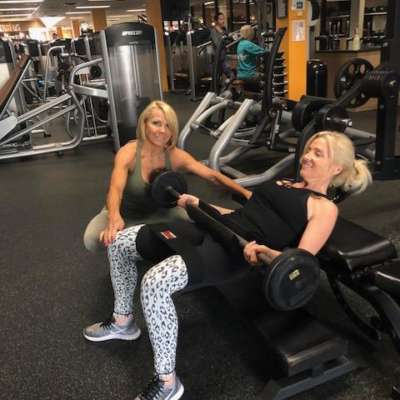
Who doesn’t want good-looking glutes? But it’s more than just appearance, much more.
Kellie Meigel
Glutes, glutes, glutes!
Anyone who knows me knows I’m all about the glutes. You’ve seen me around the gym with an arm-full of mini bands, incorporating glute exercises for myself and my clients such as band walks, kickbacks, and hip thrusters. Of course, aesthetically speaking, who doesn’t want good-looking glutes? But it’s more than just appearance, much more. When the glutes are not strong, you end up recruiting other muscles to do big jobs they are not meant to do. The lower back takes up most of the slack, as do your hamstrings, quads, and other surrounding muscles. Daily sitting, lack of exercise, general lack of physical activity—these habits can lead to a condition known as gluteal amnesia. Also known as dead butt syndrome, gluteal amnesia occurs when the gluteal muscles “forget” how to activate properly. Even people performing great exercises often aren’t properly activating their glutes at all. Once you learn how to activate your glutes properly and master the feeling of strong glute contractions, you can apply what you’ve learned to your other lower body exercises, including deadlifts, squats, hip thrusters, good mornings, even planks.
Learning Curves
I’ve been studying glute training for a couple of years now after sustaining an injury just before one of my fitness competitions. At the time I just had to push through it. My glutes became so weak that I began to use my lower back muscles to compensate for the gluteal weakness, which landed me in rehab—for both the back and the glutes! I’d reached the point where my glutes looked like someone had shaken out a pillowcase and then forgot to put back the stuffing…in other words, flat!!
Kellie’s Glute Lab
Not wanting to give up competing, I began a quest to get my glutes back and discovered Dr. Bret Contreras. Bret is the glute expert…AKA “The Glute Guy.” Perhaps a silly name, but not a silly guy. Bret has a PHD in Sports Science and Bio Mechanics, and is a CSCS (Certified Strength and Conditioning Specialist). I spent endless hours studying everything I could get my hands on, including articles, journals, and clinical studies. Then, last summer, I spent a weekend in New York City at one of Bret’s glute-training labs. I learned a great deal and was inspired to develop a glute-training lab for Fitness Incentive members, which I plan to introduce this summer. With Kellie’s Glute Lab, I will be teaching proper form for some of the best glute exercises that I’ve learned—exercises that have not only changed my glutes but the glutes of my clients as well. A focal point of Kellie’s Glute Lab will be a special piece of exercise equipment, designed by Dr. Bret himself, called The Hip Thruster. The Hip Thruster is a glute-specific bench that allows for the highly effective performance of the hip thruster exercise, also developed by Bret, which is so effective that it’s been instrumental in shaping the way in which fitness professionals approach lower-body strength training since its creation in 2006. The exercise and the bench engage not one or two but all three gluteus muscles: the maximus, the minimus, and the medius, which explains the high degree of effectiveness.
Kellie’s Glute Lab will be a small group (4 or 5 persons) approach, though I’ll offer and private sessions also. I’m so excited to bring this training program to F.I., and anyone who is interested can inquire about it at the Front Desk. Of course, if you see me at the gym, by all means, stop me.
Sponsored Links
About the Author

Kellie Meigel
Kellie Meigel is certified as a Personal Trainer/Health Fitness Instructor by the Academy of Applied Training Education at Hofstra University and is also CPR/AED adult and infant-certified.

